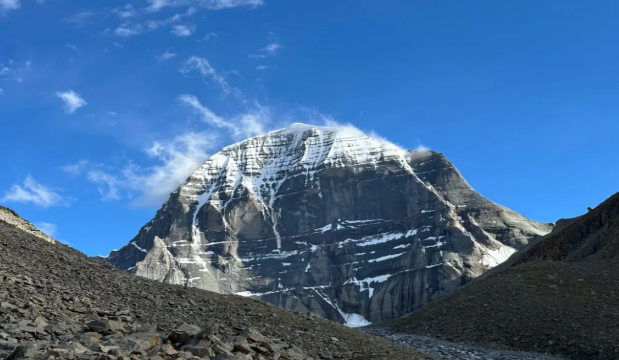The Kailash Manasarovar Tour Yatra is an extraordinary spiritual journey that transcends the boundaries of a typical adventure tour. It is a pilgrimage of immense religious and cultural importance, drawing devotees from around the world to the remote, awe-inspiring landscapes of the Tibetan Plateau. This sacred expedition is revered by followers of four major religions—Hinduism, Buddhism, Jainism, and the indigenous Bon faith—who consider the region the spiritual heart of the universe.
The Divine Nexus: A Tapestry of Faith
At the core of this pilgrimage lies Mount Kailash, a formidable, pyramid-shaped peak that remains unconquered by human climbers. Its unblemished form is considered a divine monument, and according to deeply held beliefs, to ascend it is to desecrate a holy place.
For Hindus, Mount Kailash is the mythical abode of Lord Shiva, the supreme deity of destruction and transformation, who resides here in a state of eternal meditation with his consort, Goddess Parvati. The mountain is seen as the very “Axis Mundi,” or the cosmic center of the world, a pillar connecting heaven and earth. The circumambulation of the mountain, known as the Kora or Parikrama, is believed to cleanse the soul of sins and bring the pilgrim closer to moksha (liberation).
Buddhists know the mountain as Mount Meru, a central point of their cosmology and the home of the deity Chakrasamvara. It is a site of immense spiritual power where great yogis, such as Milarepa, once meditated. For Jains, Mount Kailash is a sacred site known as Mount Ashtapada, where their first Tirthankara, Rishabhadeva, attained enlightenment and was liberated from the cycle of rebirth. The Bon religion, Tibet’s oldest spiritual tradition, calls the mountain “Yungdrung Gutsek,” the Nine-Storied Swastika Mountain, and considers it the spiritual heart of their universe. This shared reverence, despite differing religious tenets, makes the region a unique symbol of inter-religious harmony and shared spiritual quest.
Adjacent to Mount Kailash, the serene Lake Manasarovar holds equal spiritual weight. Its name, derived from the Sanskrit Manasa Sarovara, means “Mind Lake,” signifying a lake created by the divine mind of Lord Brahma. This pristine freshwater lake is a stark contrast to its saline counterpart, Rakshas Tal (“Demon Lake”), which lies nearby. While Rakshas Tal is considered inauspicious, a dip in the icy waters of Lake Manasarovar is believed to wash away all sins and purify the soul. It is the spiritual mother, the embodiment of purity and enlightenment, providing a sacred counterpoint to the masculine energy of Mount Kailash.
The Journey: Challenges and The Quest for Inner Peace
The Kailash Manasarovar tour is not a leisurely excursion; it is a rigorous and physically demanding journey. The central element is the three-day Kora, a 52-kilometer trek around the base of Mount Kailash. The most challenging section is the ascent to the Dolma La Pass, which reaches an altitude of over 18,600 feet (5,630 meters). At such elevations, the oxygen levels are significantly lower, and the risk of altitude sickness is a constant concern.
Preparation is paramount. Prospective pilgrims are advised to undergo physical conditioning, including cardiovascular and strength training, months before the trip. Acclimatization is a critical aspect of the journey, with itineraries carefully planned to allow the body to adjust to the increasing altitude. Participants must be in good health and are required to travel with a government-authorized tour operator, as independent travel in this region of Tibet is not permitted. The basic accommodations and limited facilities along the route serve as a reminder that this is a journey of sacrifice and devotion, not luxury.
The best time to undertake the Yatra is from May to October, when the weather is relatively stable and the paths are free of heavy snow. During this period, the vibrant spiritual energy is palpable, with pilgrims from various backgrounds sharing the trail, their shared purpose creating a powerful sense of community and camaraderie. Every step of the Kora is an act of devotion, a physical manifestation of an inner quest for peace and spiritual connection.
Conclusion
The Kailash Manasarovar Tour is the ultimate pilgrimage—a transformative experience that challenges the body and nourishes the soul. It is a journey to the “center of the world,” a place where the physical landscape mirrors the spiritual quest for a higher purpose. The majestic solitude of Mount Kailash and the serene purity of Lake Manasarovar provide a powerful backdrop for a profound journey of self-discovery, faith, and enlightenment.
Frequently Asked Questions (FAQ)
Q1: How difficult is the Kailash Mansarovar Yatra?
A1: The tour is considered physically demanding, primarily due to the high altitude. The trek around Mount Kailash (the Kora) is strenuous and requires good physical fitness and mental resilience.
Q2: What is the best time to go on this tour?
A2: The best time is from May to October, when the weather is most favorable for trekking. The months of July and August can bring monsoon rains, but the routes are generally still accessible.
Q3: Is a visa required for the tour?
A3: Yes, a Chinese visa and special permits for the Tibet Autonomous Region are mandatory. These are typically arranged by the authorized tour operator as part of the package.
Q4: Can I travel to Kailash Manasarovar alone?
A4: No, independent travel is not permitted. All tourists must travel in a group with a registered tour operator, as mandated by the Chinese government.
Q5: Why has Mount Kailash never climbed?
A5: Mount Kailash is considered a sacred mountain by four major religions. Climbing it is strictly prohibited by both religious beliefs and government regulations to preserve its spiritual sanctity.

